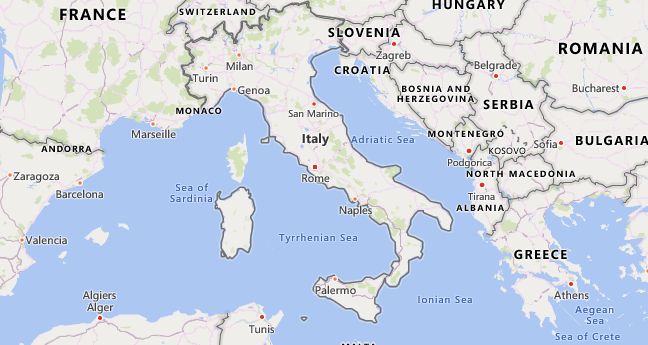There are 36 high school codes in Italy today, according to the ACT. The full list is shown below by city, with name of each high school and the city where the school is located (based on the ACT official site). You can search a school code by pressing “Ctrl” + “F” and then type school name or 6-digit school code.
Map of Italy
High School Codes by City
- High School Code
- 748330
- High School Code
- 748051
- High School Code
- 748050
- High School Code
- 748071
- High School Code
- 748645
- High School Code
- 748060
- High School Code
- 748070
- High School Code
- 748160
- High School Code
- 748076
- High School Code
- 748209
- High School Code
- 748240
- High School Code
- 748251
- High School Code
- 748281
- High School Code
- 748246
- High School Code
- 748239
- High School Code
- 748247
- High School Code
- 748252
- High School Code
- 748010
- High School Code
- 748009
- High School Code
- 748287
- High School Code
- 748344
- High School Code
- 748480
- High School Code
- 748355
- High School Code
- 748360
- High School Code
- 748400
- High School Code
- 748404
- High School Code
- 748431
- High School Code
- 748600
- High School Code
- 748560
- High School Code
- 748008
- High School Code
- 748282
- High School Code
- 748643
- High School Code
- 748644
- High School Code
- 748641
- High School Code
- 748084
- High School Code
- 748646
The above lists CEEB codes (College Entrance Examination Board) for all accredited Italy high schools. Please be informed that the list of high school codes in Italy may change throughout the year. If you can’t find codes for the high schools of your interest, please write to us or come back at a later time. We will update our database soon after a new high school code is added to the country of Italy.
Country Abbreviations
ITA is the three-letter country code of Italy, and IT is the two-letter country code of Italy. The two-letter suffix is used in top-level domains on the Internet as .it.
Country facts
- Official name: Italian Republic
- Vehicle registration number: I.
- ISO-3166: IT, ITA (380)
- Internet domain:.it
- Currency: 1 euro (€) = 100 cents
- Area: 301,340 km²
- Population (2018): 60.4 million
- Capital: Rome
- Official language (s): Italian
- Form of government: Parliamentary republic
- Administrative division: 20 regions (5 of them with special status)
- Head of State: President Sergio Mattarella
- Religion (s) (2010): 83.3% Christians (Catholics), 12.4% non-denominational, Muslims
- Time zone: Central European Time
- National holiday: June 2nd
Location and infrastructure
- Location (geographical): Southern Europe
- Position (coordinates): between 47 ° 05 ‘and 35 ° 47’ north latitude and 6 ° 33 ‘and 18 ° 31’ east longitude
- Climate: In the north a warm temperate climate, otherwise a Mediterranean climate
- Highest mountain: Mont Blanc de Courmayeur (4748 m)
- Road network (2007): 487 700 km (paved)
- Railway network (2014): 20 182 km
Population
- Annual population growth (2018): 0.2%
- Birth rate (2018): 8.5 per 1000 residents.
- Death rate (2018): 10.5 per 1000 residents.
- Average age (2018): 45.8 years
- Average life expectancy (2018): 82.4 years (women 85.2; men 79.7)
- Age structure (2018): 13.6% younger than 15 years, 21.7% older than 65 years
- Literacy rate (15-year-olds and older) (2015): 99.2%
- Mobile phone contracts (pre-paid and post-paid) (2017): 141 per 100 residents
- Internet users (2017): 61 per 100 residents
Economy
- GDP per capita (2017): US $ 31,997
- Total GDP (2017): US $ 1,939 billion
- GNI per capita (2018): US $ 33,560
- Education expenditure (2014): 4.1% of GDP
- Military expenditure (2017): 1.1% of GDP
- Unemployment rate (2017): 11.3%
Climate
The long stretch over almost 10 degrees of latitude and the strong elevation structure result in very different climatic conditions. In the Southern Alps, the Po Valley and the Northern Apennines, the transition from the Central European to the Northern Mediterranean climate takes place, from prevailing summer rain to autumn and spring precipitation. The southern Alpine valleys, the lake areas on the edge of the Alps and the Ligurian coast are protected from the cold winter Po Plain (winter health resorts). To the south of Rome, precipitation falls mainly in winter, followed by a dry, hot summer. The arid period lasts 1–2 months in central Italy and 4–6 months in Sicily.
While the mountains receive over 1,000 mm of precipitation (in the Alps up to 3,000 mm) per year, on the east side of the Apennines and in basins there are dry areas with less than 500 mm of precipitation, because the precipitation generally falls when fronts with westerly winds pass through. Snow covers above 2,000 m in height also persist in the southern Apennines for a long time. There are around 800 glaciers in the Italian Alps, 200 in the Aosta Valley alone.

